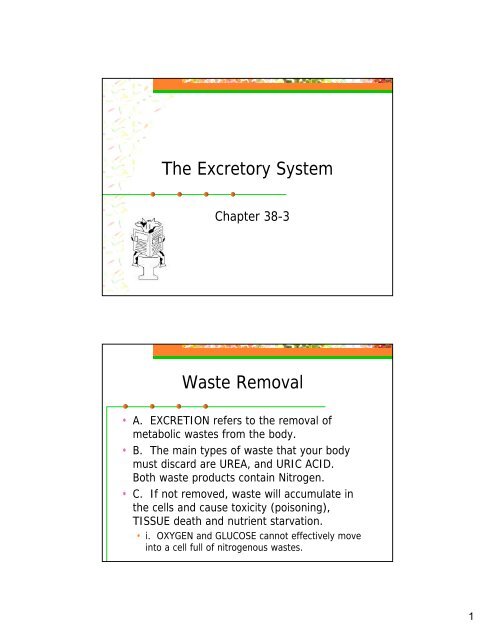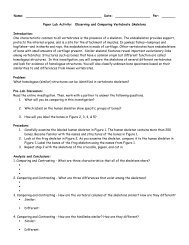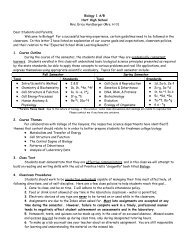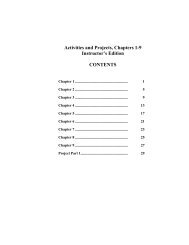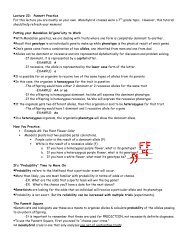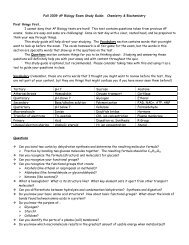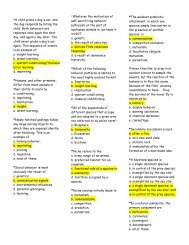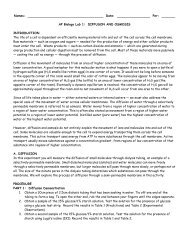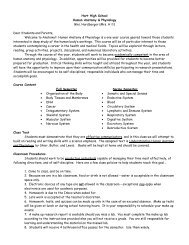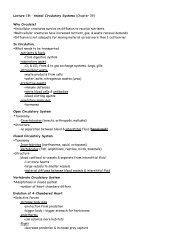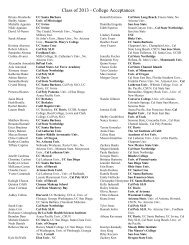Anatomy Notes 9 The Excretory System - Hart High School
Anatomy Notes 9 The Excretory System - Hart High School
Anatomy Notes 9 The Excretory System - Hart High School
You also want an ePaper? Increase the reach of your titles
YUMPU automatically turns print PDFs into web optimized ePapers that Google loves.
<strong>The</strong> <strong>Excretory</strong> <strong>System</strong><br />
Chapter 38-3<br />
Waste Removal<br />
• A. EXCRETION refers to the removal of<br />
metabolic wastes from the body.<br />
• B. <strong>The</strong> main types of waste that your body<br />
must discard are UREA, and URIC ACID.<br />
Both waste products contain Nitrogen.<br />
• C. If not removed, waste will accumulate in<br />
the cells and cause toxicity (poisoning),<br />
TISSUE death and nutrient starvation.<br />
• i. OXYGEN and GLUCOSE cannot effectively move<br />
into a cell full of nitrogenous wastes.<br />
1
Your Kidneys<br />
• A. Your kidneys are the organs responsible<br />
for filtering waste products from your blood.<br />
Without a kidney (or substitute), you would<br />
die from wastes and actually DROWN in<br />
excess body fluids in a period of about 3-4<br />
days.<br />
• B. <strong>The</strong> kidneys are located in the small of the<br />
BACK, one behind the stomach, and the other<br />
behind the liver.<br />
Your Kidneys<br />
• C. <strong>The</strong>re are<br />
several regions of<br />
the kidney:<br />
• a. CORTEX: outer<br />
area of the kidney<br />
• b. MEDULLA: middle<br />
area of the kidney<br />
• c. RENAL PELVIS:<br />
inner region with<br />
collecting ducts for<br />
urea<br />
2
Your Kidneys<br />
• D. Blood enters the<br />
kidney through the<br />
RENAL ARTERY, and<br />
leaves through the<br />
RENAL VEIN. <strong>The</strong><br />
renal artery<br />
transports nutrients<br />
to the kidney for use<br />
and waste to the<br />
kidney for filtration.<br />
Your Kidneys<br />
• E. NEPHRONS are tiny filters in each kidney<br />
(here is where URINE is made). <strong>The</strong>re are<br />
roughly one MILLION per kidney and they are<br />
made up of the following parts:<br />
• a. BOWMAN’S CAPSULE: encloses a bed of capillaries;<br />
blood from capillaries is pushed through Bowman’s<br />
capsule for filtration<br />
• b. GLOMERULUS: capillary bed; gets blood from renal<br />
artery<br />
• c. RENAL TUBULE: wastes travel through this tube<br />
• i. Renal tubule consists of 3 parts including the LOOP OF<br />
HENLE. This structure helps COLLECTING DUCTS reabsorb<br />
any water that might be mixed in the waste by keeping a high<br />
NaCl concentration outside the ducts so that osmosis can<br />
occur.<br />
3
<strong>The</strong> Nephron<br />
<strong>The</strong> Filtration Process<br />
(How your kidneys maintain homeostasis)<br />
• A. Blood enters the kidney through the RENAL<br />
ARTERY which breaks down into arterioles in the<br />
cortex.<br />
• B. Capillaries end in the GLOMERULUS which is<br />
nicely fitted into Bowman’s Capsule. Water, waste,<br />
glucose, and salts are forced into the Bowman’s<br />
Capsule by high pressure (this is where the<br />
FILTRATION process takes place)<br />
• C. Some of the filtrate must be taken back by<br />
osmosis of active transport into the CIRCULATORY<br />
system because is contains “good stuff.”<br />
4
<strong>The</strong> Filtration Process<br />
(How your kidneys maintain homeostasis)<br />
• D. <strong>The</strong> URINE (fluids and wastes including<br />
urea) collects in collecting ducts. From<br />
there it moves through the URETER (a tube<br />
for urine transport) and is stored in the<br />
BLADDER until it is too full and contracts.<br />
At that point urine leaves the bladder<br />
through the URETHRA.<br />
<strong>The</strong> Filtration Process<br />
(How your kidneys maintain homeostasis)<br />
• i. Did you know that your urine is sterile? Unless you<br />
have a bodily infection, your urine should be clean of<br />
bacteria or viruses. You can use it as an emergency<br />
antiseptic (think “Survivor”), and some people still<br />
think urine has healing value (yes, they drink it and<br />
make medicines out of it). GROSS!<br />
• ii. If your kidneys are failing their filtration duties, you<br />
may need mechanical kidney filtration called DIALYSIS.<br />
• iii. A fairly common kidney disorder is KIDNEY<br />
STONES. Kidney stones are made of CRYSTALLIZED<br />
UREA. <strong>The</strong>y are extremely painful and should be<br />
treated by a doctor. Treatment may include letting the<br />
stone pass, surgery, or electrical shock to break up the<br />
stone.<br />
5
<strong>Excretory</strong> <strong>System</strong><br />
6


